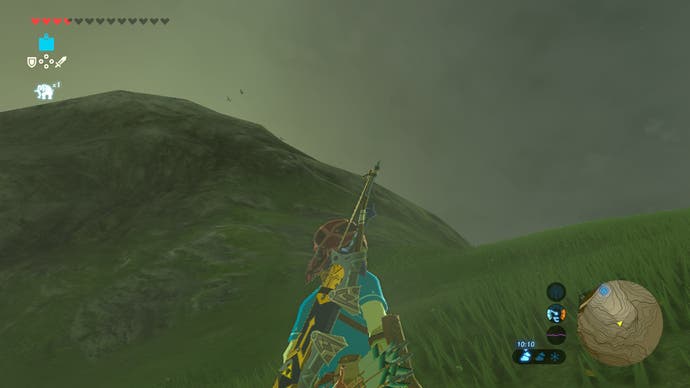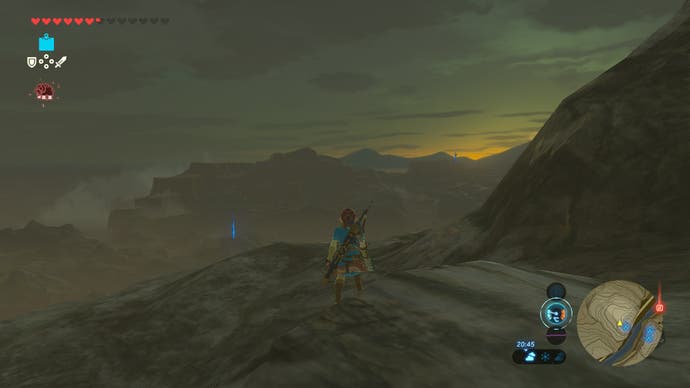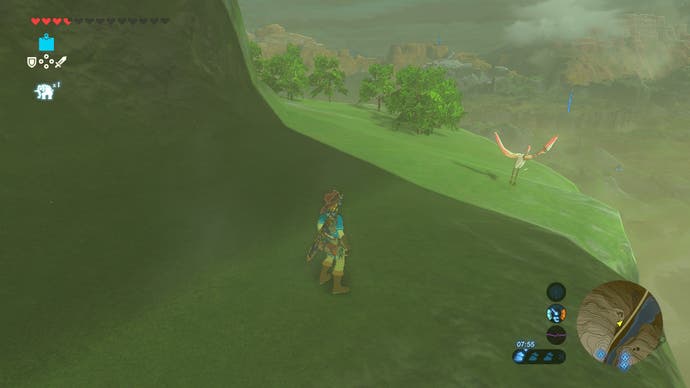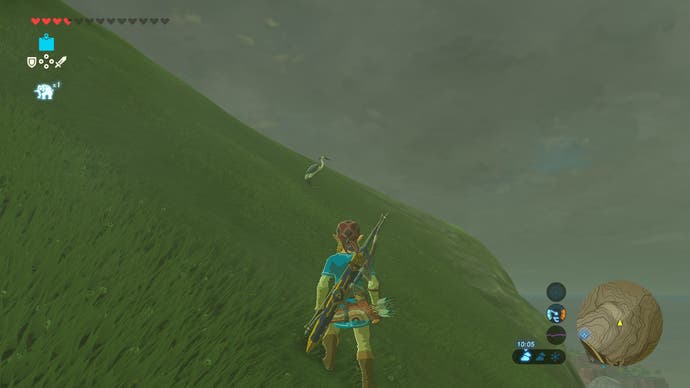In praise of The Legend of Zelda: Breath of the Wild's uncanny, inhuman mountains
Dueling Peaks!
My favourite Zelda moments generally don't have much to do with Zelda. They're not moments of heroism or even action, to be honest. If anything, they tend towards the opposite: a little change in the world that comes unannounced, an accidental glimpse of something from just the right angle in a quiet moment when I think I'm busy doing something else.
I'm talking about moments like the one in Link to the Past where you climb the mountain and the lovely plump, rounded trees of Hyrule which you've spent so much time with up-close are suddenly seen from a distance, far below you. Still plump, still rounded, but coming together to form something larger than their individual selves - a forest!
There's another moment, from Wind-Waker, that I love just as much. It's Dragon Roost Island, an early part of the game, and I guess I'm climbing towards a boss. Outside, hopping around on the wind-cleaned rock, I'm messing about with the eyeglass and I see a distant part of the same island, the same cliff, where one of those Kargaroc birds is sat in their straw nest. Simultaneously goofy and rather regal, this is a creature I haven't seen up close yet, so this is a glorious fortuitous sneak at what's ahead.
Looking back now, it's kind of weird that both of these moments - which, truly, are right up there for me, above finding the sword in the quiet glade, above the horseman leaping from oil paintings - both of these moments take place on mountains. Zelda is not a series about mountains, but it's a series where mountains seem to get the best out of it. Mountains play a funny role here. For me, they're where the game steps away from its rituals and rhythms and starts to feel real.
I say all of this because I returned to Breath of the Wild this week, a game I love and sort of hate, a game that thrills me and completely bores me by turn. Weirdly, it's the parts that I hate, the parts that bore me, that also make me suspect it's a proper masterpiece. Breath of the Wild rejects so much of the clockwork that allows me to chug through Zeldas in a warm, almost hypnotised state of glee. In its huge Hyrule, I suddenly run out of road, or find myself properly lost with nothing I much want to do. The game is hand-made and beautifully wrought, but of all Zeldas it's the one where its world feels too big to care too much about the player all the time. It wants the best out of you, and until you find how to give it your best, well, you'll have to be bored and annoyed.
This week, like every week, I tried to do a few straggly shrines but couldn't find any. I thought about taking on the next big beast, but thought also about how tricky and involved I had found the last one. So I did what I always do in Breath of the Wild. In the face of so much I had to do, I chose something I wanted to do instead. I picked a mountain and decided I would try to climb it. Two mountains in this case. Dueling Peaks, the dramatic landmass that always feels to me like it's at the centre of the map, but isn't. The mountains that are split down the middle, and draw my eye far more than the brighter, showier Mount Doom.


Breath of the Wild's mountains are pretty special. Compared to those in other Zeldas, they feel truly vast. Sure, unlike even the lamest mountains on earth, even the highest of Breath of the Wild's peaks can be climbed in minutes. But the game does a lot to make those minutes seem much longer.
How does it do this? I have never entirely figured it out. The animation helps, with its sense of weary exertion, of a body adapting to different inclines as you go. And the rock itself helps too, the warp of the wall you're on moving you gently one way and another over time, shifting the surrounding views around you. This is clever stuff. Climbing Dueling Peaks this week, I realised that the little aprons of rock that form regular ledges and paths as you climb higher, not only allow you to regain stamina, but also exist to obscure the summit in stages, so as you pass each one you get a fresh sense of how far, even now, you still have to go. The mountain is one vast thing, but the designers have found a means to reveal it to you in stages. It's almost a form of editing.


Those aprons - in Dueling Peaks, I honestly believe that they are almost everything. I love, for instance, how the discoveries of scattering animals you sometimes encounter on these aprons of grass and stone always brings a kind of sadness as you climb. Here, they are telling you, is a game that is willing to make things you might or might not see - or rather, a game that is willing to give you the freedom to visit spots at the wrong moment. And even the right moments are so fleeting, aren't they? Here are some birds you have come across, but the very moment you appear they take to the sky. Here's a fox, bright red against a mass of grey and green, but he pads off whenever you get close. What a place! This is a world that calls out again and again, reminding the player that it cannot be owned, only - briefly - experienced.
The aprons tie into traversal too, which is still a puzzle with Breath of the Wild's climb-anywhere system, but a different puzzle to the puzzle that older Zeldas used to stage. It's no longer a case of asking: how do I get past these unclimbable barriers? Instead, you ask: how can I use my pool of energy to get to a spot where I can pause and refill? How can I thread myself from apron to apron? To me this process feels like writing, like the maddening, life-enriching, delicate and tentative process of trying to make a single sentence do what you want it to do. It reminds me of the moments where you keep at it with a sentence long past the point you have run out of enthusiasm for the approach you have taken.
Eventually this week I reached the top, and as often happens, discovered a shrine that I had already completed, which meant that this was a mountain I had already climbed before, a victory savoured and then forgotten entirely. I tried to imagine what I was doing on that particular play session, where I had come from, where I might have planned on going next. But I couldn't remember a thing, of course. Too much time passed. Too much rock and earth and sky.

And ultimately, it's that scale above all else that makes the mountains special in this particular Zelda, I think. For all the Hyrules we've explored before, I would still argue that Zelda's designers are miniaturists at heart: they like to get in close with the rich detailing, with the precision puzzles that feel like they've been put together through a jeweler's loupe, with those carvings and tumbling ivy that settle perfectly on the walls of a dungeon chamber and give you a sense that this place is ancient but also filled with ancient meaning. Richness in the small things!
But here the mountains are huge, and so they feel uncanny and almost alien, because you look at these huge spaces and try to spy the miniaturists at work, and for once, they're trying to hide from you, to create perfect playgrounds of dead stone and magical one-off happenstance memories, all while they pretend that they were never here.


